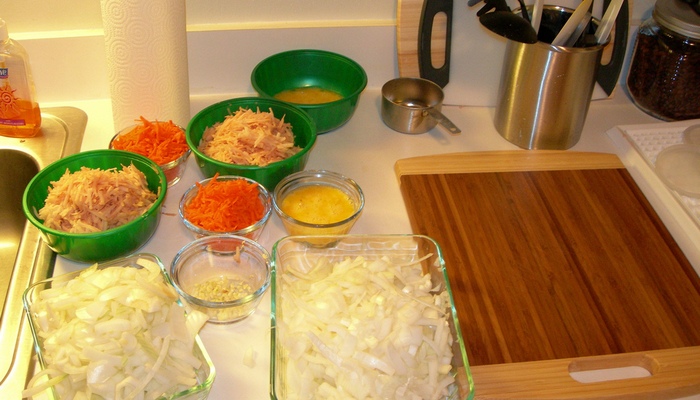 Pet owners take the health of their dogs very seriously. It's up to us to make decisions that will benefit our Fido's overall health and well-being. Last week I researched a new exercise craze called doga (yoga with dogs), and this week I wanted to learn more about making your own dog food and treats. Not only are there numerous health benefits for your dog, but making your own food and treats will save you money on commercial foods and vet bills too.
Pet owners take the health of their dogs very seriously. It's up to us to make decisions that will benefit our Fido's overall health and well-being. Last week I researched a new exercise craze called doga (yoga with dogs), and this week I wanted to learn more about making your own dog food and treats. Not only are there numerous health benefits for your dog, but making your own food and treats will save you money on commercial foods and vet bills too.
Homemade dog food and treats are growing in popularity with pet parents. Still, many think that it takes too much time or it's too expensive. If you are properly prepared, you can prep and make meals and snacks for your dog in advance, and it won't take any longer than a few minutes per day. Pet parents on a budget can find affordable recipes too!
There have been many dog food scares – mostly due to recalls – in recent months, and it is making many dog owners wonder about the health and safety of the commercial foods they are feeding their pets. There are advantages and disadvantages to any dog food diet, but after my research this week I believe there are a lot more pros than cons to making your own dog food and treats.

Woman's Day magazine isn't the typical place that you'd expect to find information about homemade dog food and treats, but this article explains some of the benefits of homemade dog food compared to store bought foods. I like that they discuss the importance of choosing quality ingredients.
What many pet parents don't realize is that making your own dog food and treats is only as good as the ingredients that you select.
You can still add fillers and artificial ingredients to your homemade food, but what sense would that make? If you make that choice your homemade food and treats won't be any healthier than commercial dog food brands. If you use fresh, natural, organic ingredients and stay away from processed foods and artificial ingredients, your homemade dog food and treats will be healthy and safe for your pet.
- When you're in control of the food-making process, you get to choose only the freshest, most wholesome ingredients. Recommended foods include cooked brown rice, boiled vegetables, cooked ground beef and boiled chicken or turkey. There are hundreds of different homemade pet food recipes available. In most cases, you can refrigerate unused portions for up to three days, so your dog will always be fed fresh food at every meal.
Quality ingredients will cost you a little more, but they will be much better for your dog in the long run. Cost isn't the only drawback to making your own dog food and treats. Fun Times Guide has a site dedicated to dogs, and they've written a easy-to-read article about making your own pet food.
They touch on the drawbacks of the diet, which can include:
- Granted, there are some drawbacks to making your dog’s meals yourself such as:
- Having to take the time to prepare those meals.
- Educating yourself on what kinds of foods are safe for your dog to eat (some foods like grapes, avocados, and chocolate can be fatal if your dog eats them).
- Learning about recipes for dog food and finding ones your dog will eat.
- Finally, it is very important that your dog eat a balanced diet as well — in order to stay healthy. So it’s also necessary that you learn about what constitutes a balanced diet for your dog.
As I mentioned, there are a lot more pros to this doggy diet than there are cons. Another dog treats site has published a very extensive article by Anna Smith about making your own dog food and treats. It has information about the health benefits, nutritional information that dog owners need to be aware of, and it also includes some great recipes.
It's important that Smith elaborates on the nutritional needs of pets. Making homemade dog food isn't as easy as throwing a protein source and some fruits and veggies together and calling it dog food. You need to know exactly what your dog's nutritional needs are so you can provide him with a healthy, balanced diet.
Not only does this article include some great information, there are some nice graphics that show the breakdown of canine nutritional requirements as well.
- Protein and the fats that are associated with meats help your dog’s digestive system to function properly. With most cooked homemade dog food recipes, you will need to add an additional fat supplement to meet the amount of fats your dog needs.
Many experts agree that making your own dog food and treats is a great alternative to purchasing commercial foods. Dr. Karen Becker, DVM, has a great site that offers information to pet parents on almost any topic involving canines. She's written a great article about homemade dog food, and there is a quick video that explains the advantages of making your pet's food.
She gives some great tips for pet parents on a budget too:
- Another benefit of switching to homemade is you can save money by buying large quantities of meats and vegetables when they are on sale. You can prepare, package and freeze your homemade pet meals weeks or even months ahead of time.You can also pair up with friends who have pets to buy ingredients in even larger quantities. It can be both economical and a time saver if you can spread the expense and meal prep work among the entire group.Another wonderful benefit of preparing a homemade diet is that when you follow a recipe for balanced meals, which is what I’m about to recommend, you’ll know for a fact you’re doing the best job possible in nourishing your pet.
JoAnna Lou, of The Bark, did an interview with Barbara Laino. Laino is a certified holistic health counselor and teaches classes on making nutritious food (for people and pets alike) at her organic farm in Warwick, N.Y. Lou spoke with her about how and why pet parents should consider making their dog's food and treats.
Laino talked about many different homemade diets that owners can create in their own kitchen. Many people think of raw food when they think of homemade diets, but that isn't always the case. You can cook your pet's food if you wish or feed them raw – it's completely up to you, and their are advantages and disadvantages to each method. Just be sure to speak with your veterinarian and do your research.
- I think people get hooked on the raw concept, but it’s not all about raw. Whatever you feel comfortable with, whether it’s boiling chicken breasts or grinding raw chicken necks … any time you’re preparing food using fresh ingredients, it’s going to be a thousand times better than what you’re getting from kibble.
You should always speak with your veterinarian before making a drastic change to your pet's diet. He will know your dog's specific needs and be able to guide you in the right direction. No matter what your pet's nutritional needs, there is certainly a way to give him that with a homemade diet. It may just take some extra research and work on your end.
Once you've got a good understanding of exactly what your dog needs, you can start looking for recipes. I found a ton of great sites that offered some really wonderful, healthy recipes. Of course, you'll need to keep your dog's palate in mind when selecting recipes as well. If he doesn't care for chicken, you'll need to find recipes that use a different protein source, or substitute a different protein source, like fish or beef, for the chicken.
Here are some of the sites I found that offered a nice variety of recipes:
- 5 Droolworthy Dog Treat Resipes
- Dog Cookies!
- Recipes for Dogs
- Home Cooking Recipes for Diabetic Pets
- 6 Dog Food Recipes to Try
Making your own dog food and treats is rewarding for you and your pet. If you cook for your dog at home or stumble upon some great recipes in your research, please share them in the comments below. Any tips, tricks or recipes that you share will help other pet owners that are already cooking for their dog or are interested in switching their dog to a homemade diet.













